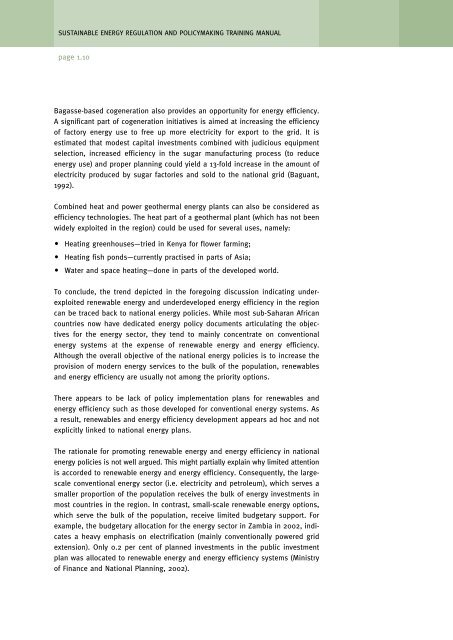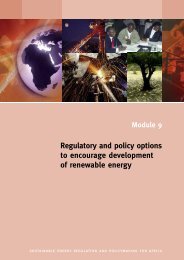Overview of renewable energy and energy efficiency - unido
Overview of renewable energy and energy efficiency - unido
Overview of renewable energy and energy efficiency - unido
- No tags were found...
Create successful ePaper yourself
Turn your PDF publications into a flip-book with our unique Google optimized e-Paper software.
SUSTAINABLE ENERGY REGULATION AND POLICYMAKING TRAINING MANUALpage 1.10Bagasse-based cogeneration also provides an opportunity for <strong>energy</strong> <strong>efficiency</strong>.A significant part <strong>of</strong> cogeneration initiatives is aimed at increasing the <strong>efficiency</strong><strong>of</strong> factory <strong>energy</strong> use to free up more electricity for export to the grid. It isestimated that modest capital investments combined with judicious equipmentselection, increased <strong>efficiency</strong> in the sugar manufacturing process (to reduce<strong>energy</strong> use) <strong>and</strong> proper planning could yield a 13-fold increase in the amount <strong>of</strong>electricity produced by sugar factories <strong>and</strong> sold to the national grid (Baguant,1992).Combined heat <strong>and</strong> power geothermal <strong>energy</strong> plants can also be considered as<strong>efficiency</strong> technologies. The heat part <strong>of</strong> a geothermal plant (which has not beenwidely exploited in the region) could be used for several uses, namely: Heating greenhouses—tried in Kenya for flower farming; Heating fish ponds—currently practised in parts <strong>of</strong> Asia; Water <strong>and</strong> space heating—done in parts <strong>of</strong> the developed world.To conclude, the trend depicted in the foregoing discussion indicating underexploited<strong>renewable</strong> <strong>energy</strong> <strong>and</strong> underdeveloped <strong>energy</strong> <strong>efficiency</strong> in the regioncan be traced back to national <strong>energy</strong> policies. While most sub-Saharan Africancountries now have dedicated <strong>energy</strong> policy documents articulating the objectivesfor the <strong>energy</strong> sector, they tend to mainly concentrate on conventional<strong>energy</strong> systems at the expense <strong>of</strong> <strong>renewable</strong> <strong>energy</strong> <strong>and</strong> <strong>energy</strong> <strong>efficiency</strong>.Although the overall objective <strong>of</strong> the national <strong>energy</strong> policies is to increase theprovision <strong>of</strong> modern <strong>energy</strong> services to the bulk <strong>of</strong> the population, <strong>renewable</strong>s<strong>and</strong> <strong>energy</strong> <strong>efficiency</strong> are usually not among the priority options.There appears to be lack <strong>of</strong> policy implementation plans for <strong>renewable</strong>s <strong>and</strong><strong>energy</strong> <strong>efficiency</strong> such as those developed for conventional <strong>energy</strong> systems. Asa result, <strong>renewable</strong>s <strong>and</strong> <strong>energy</strong> <strong>efficiency</strong> development appears ad hoc <strong>and</strong> notexplicitly linked to national <strong>energy</strong> plans.The rationale for promoting <strong>renewable</strong> <strong>energy</strong> <strong>and</strong> <strong>energy</strong> <strong>efficiency</strong> in national<strong>energy</strong> policies is not well argued. This might partially explain why limited attentionis accorded to <strong>renewable</strong> <strong>energy</strong> <strong>and</strong> <strong>energy</strong> <strong>efficiency</strong>. Consequently, the largescaleconventional <strong>energy</strong> sector (i.e. electricity <strong>and</strong> petroleum), which serves asmaller proportion <strong>of</strong> the population receives the bulk <strong>of</strong> <strong>energy</strong> investments inmost countries in the region. In contrast, small-scale <strong>renewable</strong> <strong>energy</strong> options,which serve the bulk <strong>of</strong> the population, receive limited budgetary support. Forexample, the budgetary allocation for the <strong>energy</strong> sector in Zambia in 2002, indicatesa heavy emphasis on electrification (mainly conventionally powered gridextension). Only 0.2 per cent <strong>of</strong> planned investments in the public investmentplan was allocated to <strong>renewable</strong> <strong>energy</strong> <strong>and</strong> <strong>energy</strong> <strong>efficiency</strong> systems (Ministry<strong>of</strong> Finance <strong>and</strong> National Planning, 2002).










